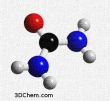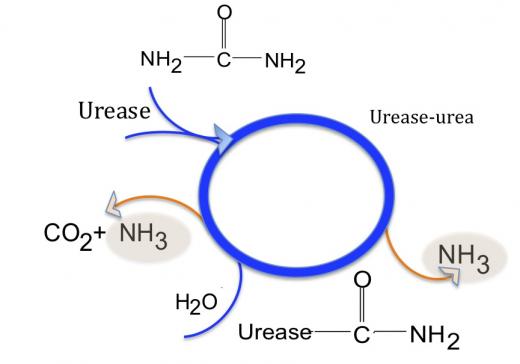Das haben sich wahrscheinlich viele angeekelt gefragt. Was macht eigentlich Harnstoff in Kosmetikmittel? Mir haben sogar 2 Chemie-Doktoranten gesagt, es sei doch eklig, Hautpflegemittel mit Harnstoff anzuwenden.
Dabei hat Urea nicht viel mit Urin zu tun. Nein es ist anders. Urin heißt so, weil Harnstoff ein Bestandteil des Urins ist und nicht weil Urea aus Urin stammt. Also seid unbesorgt und verwendet weiter eure ureahaltige Kosmetika mit Genuss.
There are probably other people who asked themselves the same question, why on earth should we apply urea (from urin) in personal care products. I was even confronted with that question by PhD students in chemistry.
However, it's completely vice versa. Actually urin is called urin, becase urea is found in our urin and not because urea is derived from urine. Don't worry and apply your urea containing cosmetics with pleasure.
 Urea, oder Harnstoff, mit einer Struktur wie in der Abbildung ist ein Bestandteil des NMFs (Natural moisturizing factor, auf Deutsch natürl. Feuchthaltefaktor) der in Stratum Corneum SC, unserer obersten (äußersten) Hautschicht existiert und für die Aufrechthaltung der Feuchtigkeit der Haut zuständig ist. Der Aufbau dieses Faktors lässt mit dem Alter und unter bestimmten Bedingungen (Umwelt, Chemikalien, Ernährung etc.) nach und liefert unsere Haut schutzlos und anfällig der Umgebung aus.
Urea, oder Harnstoff, mit einer Struktur wie in der Abbildung ist ein Bestandteil des NMFs (Natural moisturizing factor, auf Deutsch natürl. Feuchthaltefaktor) der in Stratum Corneum SC, unserer obersten (äußersten) Hautschicht existiert und für die Aufrechthaltung der Feuchtigkeit der Haut zuständig ist. Der Aufbau dieses Faktors lässt mit dem Alter und unter bestimmten Bedingungen (Umwelt, Chemikalien, Ernährung etc.) nach und liefert unsere Haut schutzlos und anfällig der Umgebung aus.
Urea is an ingredient of our NMF (Natural Moisturizing Factor), the substance naturally produced by the body and available in Stratum Corneum SC, the outermost layer of our skin. This material (including Urea) is responsible for moisture balance of the intact skin. However it's production is adversely affected by age, environmental influence, diet etc.
Urea (Harnstoff) wird erst seit ca. 40 Jahren in Kosmetikmittel verwendet. Vorher war es hauptsächlich in Arzneimittel (gegen Ekzemen, Neurodermitis, Psoriasis) verwendet. Seine Anwendung in Kosmetikmittel war sogar in einigen Ländern gar nicht zugelassen.
Er ist unter:INCI: UREA
CAS # 57-13-6
EINECS/ELINCS # 200-315-5
in dem Cosing Verzeichnis der EU unter :ANTISTATISCH, PUFFER, , FEUCHTIGKEITsSPENDER, WEICHMACHER
registriert.
Urea is being applied since about 40 years in personal care. Before that it was mainly applied in pharmaceuticals (against eczema, atopic dermatitis, psoriasis), and in some countries was even not allowed for personal care use. It is known and registered under:INCI: UREA
CAS # 57-13-6
EINECS/ELINCS # 200-315-5
in the Cosing directory of the European Union as :ANTISTATIC, BUFFERING, HUMECTANT, SKIN CONDITIONING
In Kosmetikmittel wird Urea als ein ausgezeichneter Feuchtigkeitsspender verwendet. Er bindet Wasser Moleküle, macht die Haut für wasserlösliche Wirkstoffe durchlässig und reguliert das NMF-Gleichgewicht der Haut. Gesetzlich gibt es keine Beschränkung für seinen Anteil in dem Präparat, wird aber in der Regel nicht mehr als 20% (oft zwischen 5-10%) angewendet. Für Selbstrührer lieber zwischen 1-5%.
Urea is applied as a magnificent moisturizer. It is hygroscopic, it means it can bind water molecules. It makes the skin permeable for water soluble active substances and regulates the NMF-Balance of the skin. There are no regulatory limitations for it's application in cosmetics (at least in the European Union) but it is generally not applied more than 20% (most often between 5-10%). For handcrafted cosmetics between 1-5%.
So wundervoll wie Harnstoff ist, gibt es aber auch Beschränkungen bei seiner Anwendung in Kosmetikmittel.
Es ist Temperatur- und pH-Wert empfindlich. Also in der Emulsion nicht mit der wässrigen Phase erhitzen, nicht bei einem hohen oder zu niedrigen pH-Wert verarbeiten. (optimaler pH-Wert für Urea wäre 6-8, für Hautpflegeprodukte also versucht den pH-Wert zwischen 6,5-7,0 zu behalten). Nicht alle Bestandteile einer Rezeptur und nicht alle Emulgatoren verstehen sich gut mit Urea. Das ist ein anderer Nachteil oder Beschränkung seiner Anwendung in Kosmetikmittel.
As wonderful as it is, there are limitations to its application in personal care recipes. If you're crafting emulsions and creams, you should specifically be careful applying Urea in your formulations.
Urea is sensitive to high temperatures, so you can not heat it with your water phase from the very beginning. It is as well sensitive to low and high pH (best pH is around 6-8, try to adjust the pH around 6,5-7,0 and not lower than that ) and not all emulsifiers are compatible to Urea. So please check all your ingredients and their compatibility to Urea before crafting your first 500 gr batch.

Das Diagramm am Oben zeigt die Zersetzung von Urea durch Urease (das Enzym, das Harnstoff in Ammoniak und Kohlenstoffdioxid spaltet) gespaltet. Diese Reaktion ist Basis eines Schnelltests zur Feststellung Urease-haltige Bakterien. Die Zersetzung läuft aber auch unabhängig von Urease im Wasser. d.h. ureahaltige Creme und Lotionen gehen mit der Zeit eine Zersetzung von Urea und Freisetzung von Ammoniak durch. Folge davon ist der unangenehme Geruch von Ammoniak nach der Zersetzung und Aufblähung der Tuben oder Auftauchen der Blasen in die Cremedose wegen Freisetzung von CO2. Diese Zersetzung erhöht den pH-Wert des Produktes und kann wieder manche Konservierungsmittel, welche nur in einem sauren pH-Bereich aktiv sind (Benzoesäure, Sorbinsäure) unwirksam machen. Die Zersetzung passiert sowohl im säuren pH-Bereich als auch im alkalischen Bereich, jedoch durch unterschiedliche Mechanismen. Anwendung verschiedene Puffer-Systeme wird den Anstieg vom pH-Wert, den üblen Ammoniak Geruch und die Inaktivierung von Konservierungsmitteln verhindern, kann aber wenig Einfluss auf die Zersetzung von Urea haben.
The above diagram shows the decomposition of Urea by urease, an enzyme which is present in numerous bacteria and in soil. This is actually a rapid test to detect urease-containing bacteria in the laboratory. The decomposition however happens even without urease and in water at ambient temperature and pH, however via different mechanisms in acidic or alkaline pH. It causes ammonia release with an unpleasant odor. Ammonia release increases the pH of the product and may inactivate preservatives (such as benzoic acid, sorbic acid) which are effective at low pH-ranges.
Buffering the product with different systems, may have a retardation effect on ammonia release, increasing pH and inactivation of the preservative, it can however not completely stop the decomposition of urea.
Allantoin, der euch als ein entzündungshemmendes Mittel bekannt ist und dessen Name keine Assoziation zum Urin hat, ist ein Produkt des Harnstoffes das weniger temperatur- und pH anfällig ist, seine feuchtigkeitsspendenden Wirkungen sind aber nicht mit Harnstoff vergleichbar.
Urea findet ihr als ein feines Pulver oder feine kleine Perlen. Es ist ein wasserlösliches Material, daß ihr in Shampoo, Haarspülung, Duschgel, Emulsionen aber auch in Butter (fein mörsern bei max. 30 Grad mit anderen Zutaten mischen) oder in Mineralmasken und Fruchtpulvermasken, welche vor der Anwendung mit einem Öl/einer Flüssigkeit zu einer Paste verrührt werden anwenden.
Allantoin which you know as an anti-inflammatory component and whose modern name has no association to urine, is a product of Urea. It is less sensitive to temperature or pH. It's moisturizing effect is however much lower than that of Urea.
You'll find Urea as a fine powder/Granules. It is a water soluble material which you can simply apply in hair shampoo, conditioner, shower gel, lotions and even in butters (simply grind it to a very fine powder and mix it at max. 30 degrees with the rest). Very applicable is urea in powder mineral masks which are stirred to a viscous paste with an oil or a liquid (tonic, tea, etc.) shortly before application.
Weitere Infos/ further readings:
Neues Rezeptur-Formularium, ABDA – Bundesvereinigung Deutscher Apothekerverbände
Pharmazeutisches Laboratorium Govi-Verlag Pharmazeutischer Verlag GmbH
The Decomposition of Urea in Aqueous Media: William H. R. Shaw , John J. Bordeaux
J. Am. Chem. Soc., 1955, 77 (18), pp 4729–4733
DOI: 10.1021/ja01623a011
PTA-Forum: Harnstoff richtig verarbeiten
Cosmetic composition for skin comprising urea: US Patent 6355259 Issued on March 12, 2002
 Urea, oder Harnstoff, mit einer Struktur wie in der Abbildung ist ein Bestandteil des NMFs (Natural moisturizing factor, auf Deutsch natürl. Feuchthaltefaktor) der in Stratum Corneum SC, unserer obersten (äußersten) Hautschicht existiert und für die Aufrechthaltung der Feuchtigkeit der Haut zuständig ist. Der Aufbau dieses Faktors lässt mit dem Alter und unter bestimmten Bedingungen (Umwelt, Chemikalien, Ernährung etc.) nach und liefert unsere Haut schutzlos und anfällig der Umgebung aus.
Urea, oder Harnstoff, mit einer Struktur wie in der Abbildung ist ein Bestandteil des NMFs (Natural moisturizing factor, auf Deutsch natürl. Feuchthaltefaktor) der in Stratum Corneum SC, unserer obersten (äußersten) Hautschicht existiert und für die Aufrechthaltung der Feuchtigkeit der Haut zuständig ist. Der Aufbau dieses Faktors lässt mit dem Alter und unter bestimmten Bedingungen (Umwelt, Chemikalien, Ernährung etc.) nach und liefert unsere Haut schutzlos und anfällig der Umgebung aus. 

